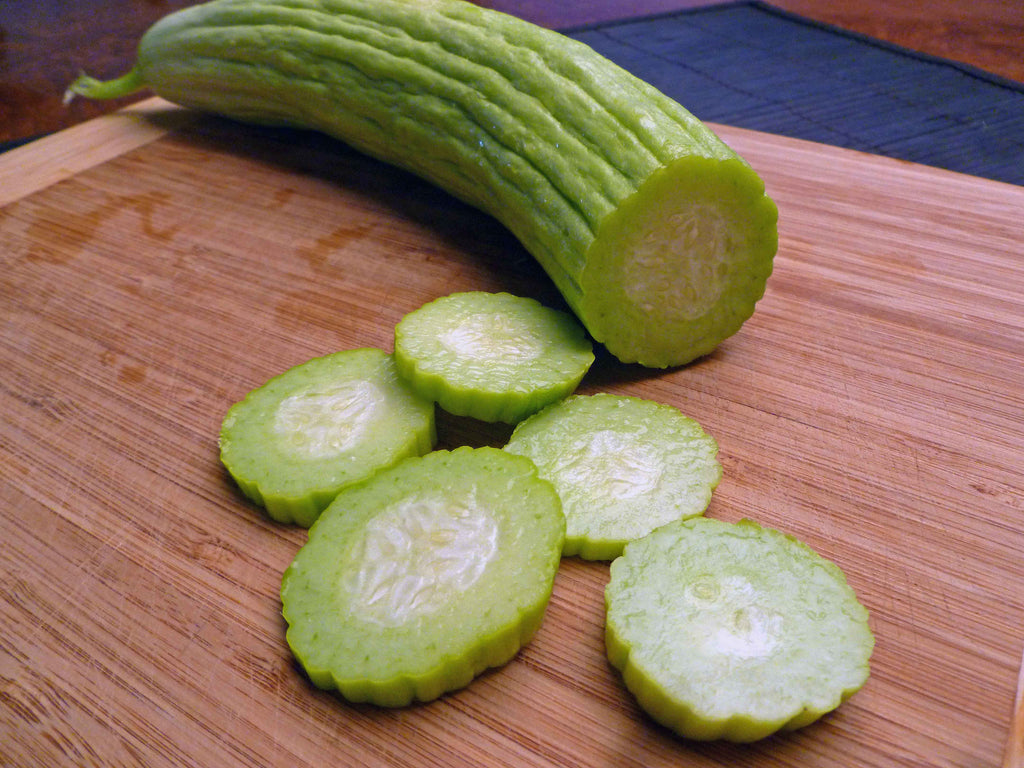
Gardening is meant to be an adventure—by growing new and different plants at home, we can in a small way experience other cultures, places, and environments. This is why we’re always excited to discover new plants, and this summer’s discover is something special indeed. Armenian cucumbers are a vining plant that produces a unique and delicious fruit. They’re easy to grow, interesting to work with, and the beautiful fruit add a special visual touch both in the garden and on the plate. Growing Armenian cucumbers at home is easy, so let’s dig in!
What are Armenian Cucumbers?
This is one of those moments where the name is misleading—just as the peanut is neither a pea nor a nut but rather a legume, Armenian cucumbers are not cucumbers. They’re closely related, however, as they are a variety of muskmelon or cantaloupe (C. melo) rather than a cucumber (C. sativus). The full scientific name for Armenian cucumber is Cucumis melo var. flexuosus, just in case you need to look it up with your local extension office or in a seed catalog.
Adding to the complications around the name, while Armenian cucumbers (along with regular cucumbers) popular in Armenia, they may not originate there. The story and history of these plants is complicated but they seem to originate in Egypt or the Levant in ancient times. They were popular throughout the region, and even in Ancient Greece and Rome—according to Pliny the Elder, they were a favorite food of the Emperor Tiberius. From there, they spread around both the Mediterranean and Asia. They remain particularly popular in those regions to this day.

How to Grow Armenian Cucumbers
Since Armenia cucumbers are a variety of C. melo, the good news is that many of you already know how to grow similar plants and that knowledge transfers beautifully to Armenian cucumbers. Like their muskmelon and cantaloupe relatives, Armenian cucumbers like long hot summers, plentiful water, and loose, rich soils with good drainage and a pH between 5.5 and 6.8. If other muskmelon species have done well in your garden, you likely have everything you need for Armenian cucumbers to succeed.
There are a few things to know, however. Armenian cucumbers don’t like being transferred or re-planted, so when possible sow them directly in the garden when the risk of frost has passed and the daytime temps are above 65℉/18°C. If you live in a place with a shorter growing season and you need to start them indoors, never fear! You can start seeds indoors four to six weeks before your last risk of frost date; you can expect germination somewhere between 7 and 20 days later. We recommend hardening off your Armenian cucumber seedlings slowly by exposing them to outside conditions for a few hours a day for about a week before transplanting. Plant them where you would cucumbers or melons—the vines get fairly long and they will climb if you give them a support.
Armenian cucumbers don’t suffer from too many pests, but cucumber and and squash beetles have been known to munch on the plant, so please keep an eye out. At the start of the season, Armenian cukes benefit from rich compost or a balanced 10-10-10 fertilizers; these are relatively heavy feeders. Fruits make take a while to appear depending on your weather and other conditions, but Armenian cucumbers generally produce a lot over the course of a season. They’re generally ready to harvest went they reach 8-10 inches/20-25cm in length. You can use them as you would a cucumber, and they make a delightfully refreshing addition to most salads and veggie trays!

Growing Armenian Cucumbers in Containers
Yes, you can grow Armenian cucumbers in containers! Just like growing them in garden beds, they like loose, rich, well-drained soil, plenty of water, and full sun. They do like a fair amount of space around the roots, so three plants in a 10-15 gallon container would be the closest we’d want to space them. Make sure to give them a trellis to climb on or plenty of space for the vines on the ground. Armenian cucumbers can be a lovely addition to a patio garden if you have the space!

Armenian Cucumbers at Home
Armenian cucumbers are a fun addition to your garden and an interesting plant to explore both horticulturally and as a culinary ingredient in the kitchen. They make a fun visual addition wherever they’re found and they’re a good conversation starter with other gardeners. Saving the seeds is easy due to their melon-type interior space, so you can keep propagating them year after year and share them with other folks or a community garden near you!
If you’re growing Armenian cucumbers, please share your experiences with us! Gardzen is all about community and we love to hear from you!

Leave a comment